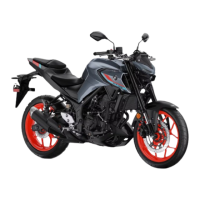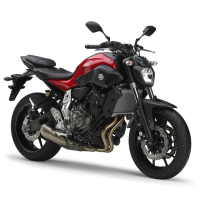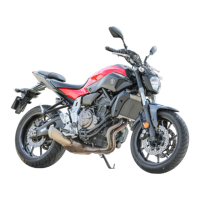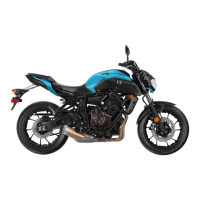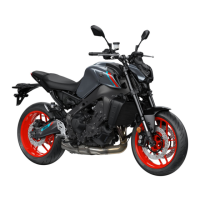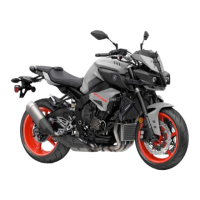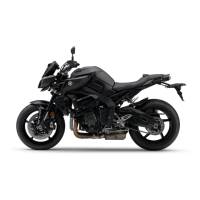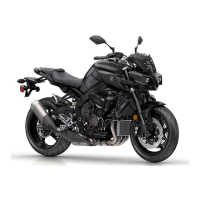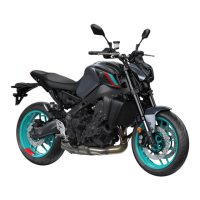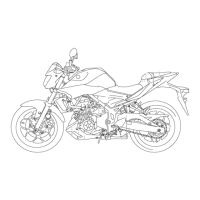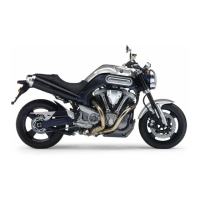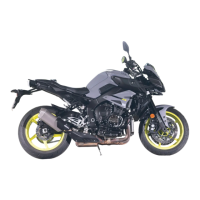Do you have a question about the Yamaha MT-25 and is the answer not in the manual?
Owner's responsibilities, rider requirements, and training.
Pre-operation checks, visibility, riding posture, and alcohol influence.
Importance of helmets and protective gear for injury prevention.
Hazards of CO from exhaust and preventative measures.
Guidelines for adding cargo/accessories to ensure stability.
Risks of aftermarket parts and user responsibility for modifications.
Critical role of helmets in preventing head injuries in accidents.
Criteria for choosing and correctly wearing a motorcycle helmet.
Identification of major components on the left side.
Identification of major components on the right side.
Identification of handlebar controls and dashboard instruments.
Operation of the main switch and steering lock positions.
Explanation of various indicator and warning lights on the panel.
Overview of the multi-function meter unit and its displays.
Explanation of left and right handlebar switch functions.
Operation and function of the clutch lever.
Operation of the shift pedal for gear changes.
Operation of the front brake lever.
Operation of the rear brake pedal.
Explanation of the Anti-lock Brake System (ABS) operation.
Fueling instructions, safety precautions, and recommended fuel.
Checks for fuel system before operation.
Checks for engine oil level and leaks.
Checks for coolant level and leaks.
Checks for front brake operation, fluid, and pads.
Checks for rear brake operation, fluid, and pads.
Checks for clutch operation and free play.
Checks for throttle grip operation and free play.
Checks operation of the sidestand switch.
Break-in procedures and recommended speed limits.
Conditions and procedure for starting the engine.
Explanation of gear positions and shifting procedure.
Tips to improve fuel efficiency.
Safety precautions for parking the motorcycle.
Location and use of the owner's tool kit.
Maintenance schedule for emission control system components.
Maintenance of the air induction system.
General maintenance and lubrication schedule.
Importance of tire condition, replacement, and pressure.
Procedure for adjusting clutch lever free play.
Checking brake fluid level and replenishing if necessary.
Checking and adjusting drive chain slack and alignment.
Cleaning and lubricating the drive chain with special lubricant.
Checking front fork condition and operation.
Checking steering for wear or looseness.
Procedure for accessing and replacing fuses.
Precautions for safely supporting the motorcycle.
General advice on troubleshooting and using genuine parts.
Troubleshooting steps for engine overheating issues.
Precautions and methods for cleaning the motorcycle.
Short-term and long-term storage instructions.
Steps to protect internal engine parts during storage.
Engine specifications including displacement and arrangement.
Fuel tank capacity and reserve amount.
Front and rear tire sizes and models.
Maximum load capacity for rider, passenger, cargo, and accessories.
Location of vehicle and engine identification numbers.
Explanation of vehicle data recording by the ECU.
Owner's responsibilities, rider requirements, and training.
Pre-operation checks, visibility, riding posture, and alcohol influence.
Importance of helmets and protective gear for injury prevention.
Hazards of CO from exhaust and preventative measures.
Guidelines for adding cargo/accessories to ensure stability.
Risks of aftermarket parts and user responsibility for modifications.
Critical role of helmets in preventing head injuries in accidents.
Criteria for choosing and correctly wearing a motorcycle helmet.
Identification of major components on the left side.
Identification of major components on the right side.
Identification of handlebar controls and dashboard instruments.
Operation of the main switch and steering lock positions.
Explanation of various indicator and warning lights on the panel.
Overview of the multi-function meter unit and its displays.
Explanation of left and right handlebar switch functions.
Operation and function of the clutch lever.
Operation of the shift pedal for gear changes.
Operation of the front brake lever.
Operation of the rear brake pedal.
Explanation of the Anti-lock Brake System (ABS) operation.
Fueling instructions, safety precautions, and recommended fuel.
Checks for fuel system before operation.
Checks for engine oil level and leaks.
Checks for coolant level and leaks.
Checks for front brake operation, fluid, and pads.
Checks for rear brake operation, fluid, and pads.
Checks for clutch operation and free play.
Checks for throttle grip operation and free play.
Checks operation of the sidestand switch.
Break-in procedures and recommended speed limits.
Conditions and procedure for starting the engine.
Explanation of gear positions and shifting procedure.
Tips to improve fuel efficiency.
Safety precautions for parking the motorcycle.
Location and use of the owner's tool kit.
Maintenance schedule for emission control system components.
Maintenance of the air induction system.
General maintenance and lubrication schedule.
Importance of tire condition, replacement, and pressure.
Procedure for adjusting clutch lever free play.
Checking brake fluid level and replenishing if necessary.
Checking and adjusting drive chain slack and alignment.
Cleaning and lubricating the drive chain with special lubricant.
Checking front fork condition and operation.
Checking steering for wear or looseness.
Procedure for accessing and replacing fuses.
Precautions for safely supporting the motorcycle.
General advice on troubleshooting and using genuine parts.
Troubleshooting steps for engine overheating issues.
Precautions and methods for cleaning the motorcycle.
Short-term and long-term storage instructions.
Steps to protect internal engine parts during storage.
Engine specifications including displacement and arrangement.
Fuel tank capacity and reserve amount.
Front and rear tire sizes and models.
Maximum load capacity for rider, passenger, cargo, and accessories.
Location of vehicle and engine identification numbers.
Explanation of vehicle data recording by the ECU.
| Displacement | 249 cc |
|---|---|
| Bore x Stroke | 60.0 mm x 44.1 mm |
| Maximum Power | 26.5 kW (36.0 PS) @ 12, 000 rpm |
| Fuel System | Fuel Injection |
| Ignition System | TCI |
| Transmission | Constant mesh, 6-speed |
| Front Suspension | Telescopic fork |
| Rear Suspension | Swingarm (Link suspension) |
| Front Brake | Hydraulic single disc, Ø 298 mm |
| Rear Brake | Hydraulic single disc, Ø 220 mm |
| Overall Length | 2, 090 mm |
| Overall Width | 745 mm |
| Overall Height | 1, 035 mm |
| Seat Height | 780 mm |
| Wheelbase | 1, 380 mm |
| Minimum Ground Clearance | 160 mm |
| Wet Weight | 165 kg |
| Fuel Tank Capacity | 14 L |
| Starter System | Electric |
| Lubrication System | Wet sump |
| Frame Type | Diamond |
| Final Drive | Chain |
| Engine Type | Liquid-cooled, 4-stroke, DOHC, 4-valve |
| Maximum Torque | 23.6 Nm (2.4 kg-m) @ 10, 000 rpm |
| Front Tire | 110/70-17M/C 54H |
| Rear Tire | 140/70-17M/C 66H |
| Clutch Type | Wet, multiple-disc |
| Oil Tank Capacity | 2.4 L |
